Literature Review: The Role of Managers in Environmental Safety
VerifiedAdded on 2023/06/07
|15
|3611
|357
Literature Review
AI Summary
This literature review examines the crucial role of managers in fostering environmental safety within organizations across various industries. It discusses the responsibilities of managers in developing a culture of environmental and social practice, utilizing tools for effective decision-making, and integrating environmental stewardship into business opportunities. The review covers various sectors, including construction, healthcare, and supply chain management, highlighting the importance of project managers, HR managers, and supply chain managers in implementing eco-friendly practices. It also emphasizes the use of green information systems, talent management, and environmental rating systems like LEED and ITACA to promote sustainable business operations. Ultimately, the review concludes that the active participation and commitment of managers are essential for achieving environmental safety and organizational sustainability.
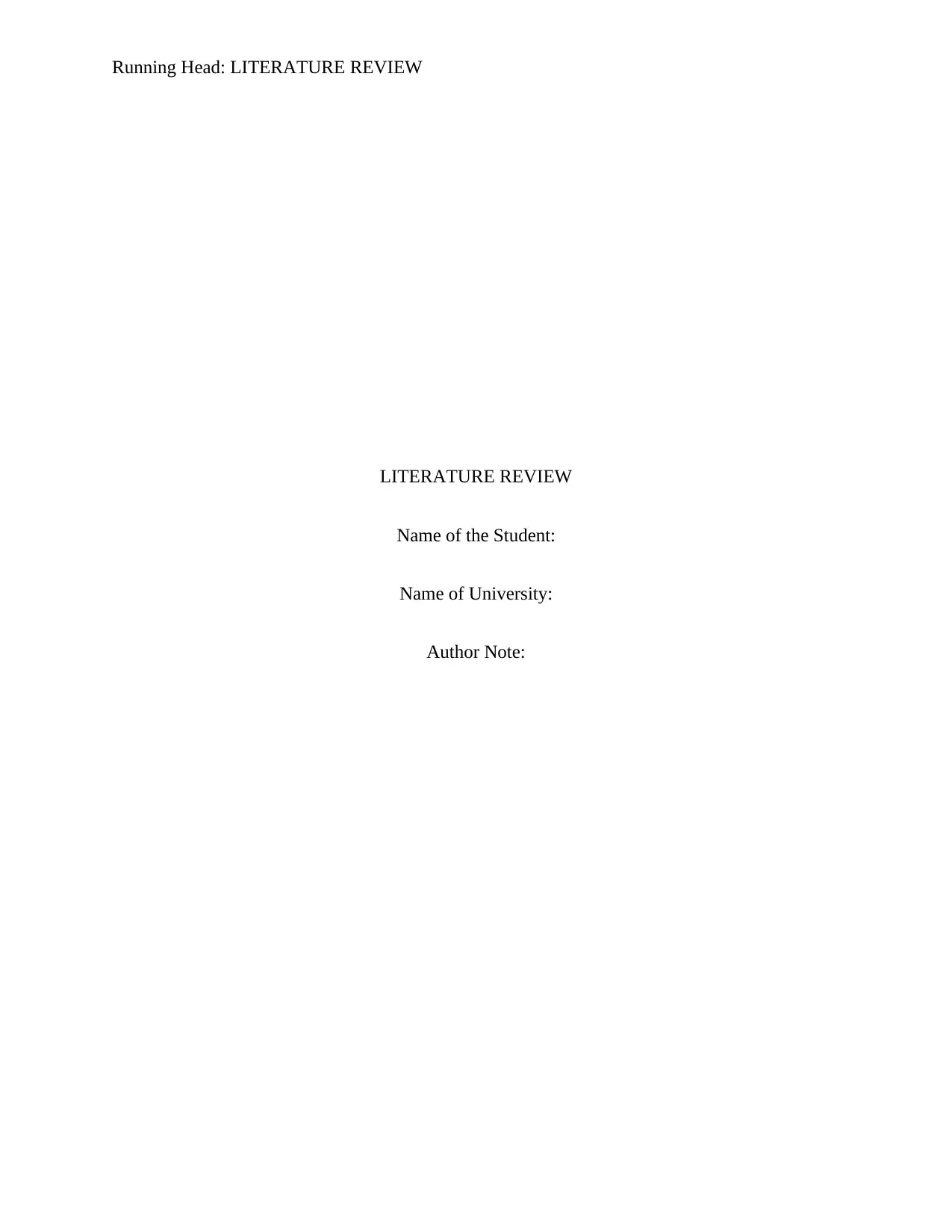
Running Head: LITERATURE REVIEW
LITERATURE REVIEW
Name of the Student:
Name of University:
Author Note:
LITERATURE REVIEW
Name of the Student:
Name of University:
Author Note:
Paraphrase This Document
Need a fresh take? Get an instant paraphrase of this document with our AI Paraphraser
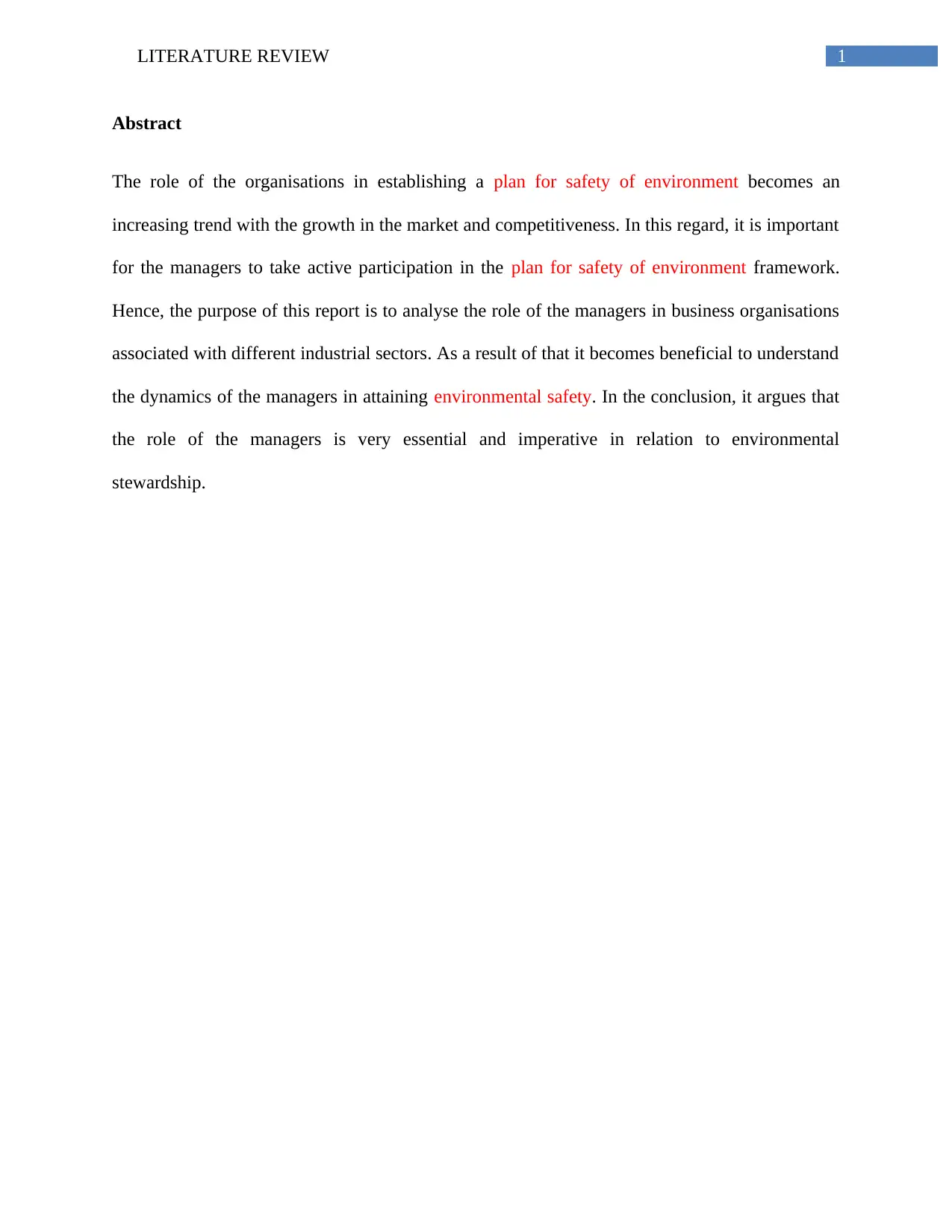
1LITERATURE REVIEW
Abstract
The role of the organisations in establishing a plan for safety of environment becomes an
increasing trend with the growth in the market and competitiveness. In this regard, it is important
for the managers to take active participation in the plan for safety of environment framework.
Hence, the purpose of this report is to analyse the role of the managers in business organisations
associated with different industrial sectors. As a result of that it becomes beneficial to understand
the dynamics of the managers in attaining environmental safety. In the conclusion, it argues that
the role of the managers is very essential and imperative in relation to environmental
stewardship.
Abstract
The role of the organisations in establishing a plan for safety of environment becomes an
increasing trend with the growth in the market and competitiveness. In this regard, it is important
for the managers to take active participation in the plan for safety of environment framework.
Hence, the purpose of this report is to analyse the role of the managers in business organisations
associated with different industrial sectors. As a result of that it becomes beneficial to understand
the dynamics of the managers in attaining environmental safety. In the conclusion, it argues that
the role of the managers is very essential and imperative in relation to environmental
stewardship.
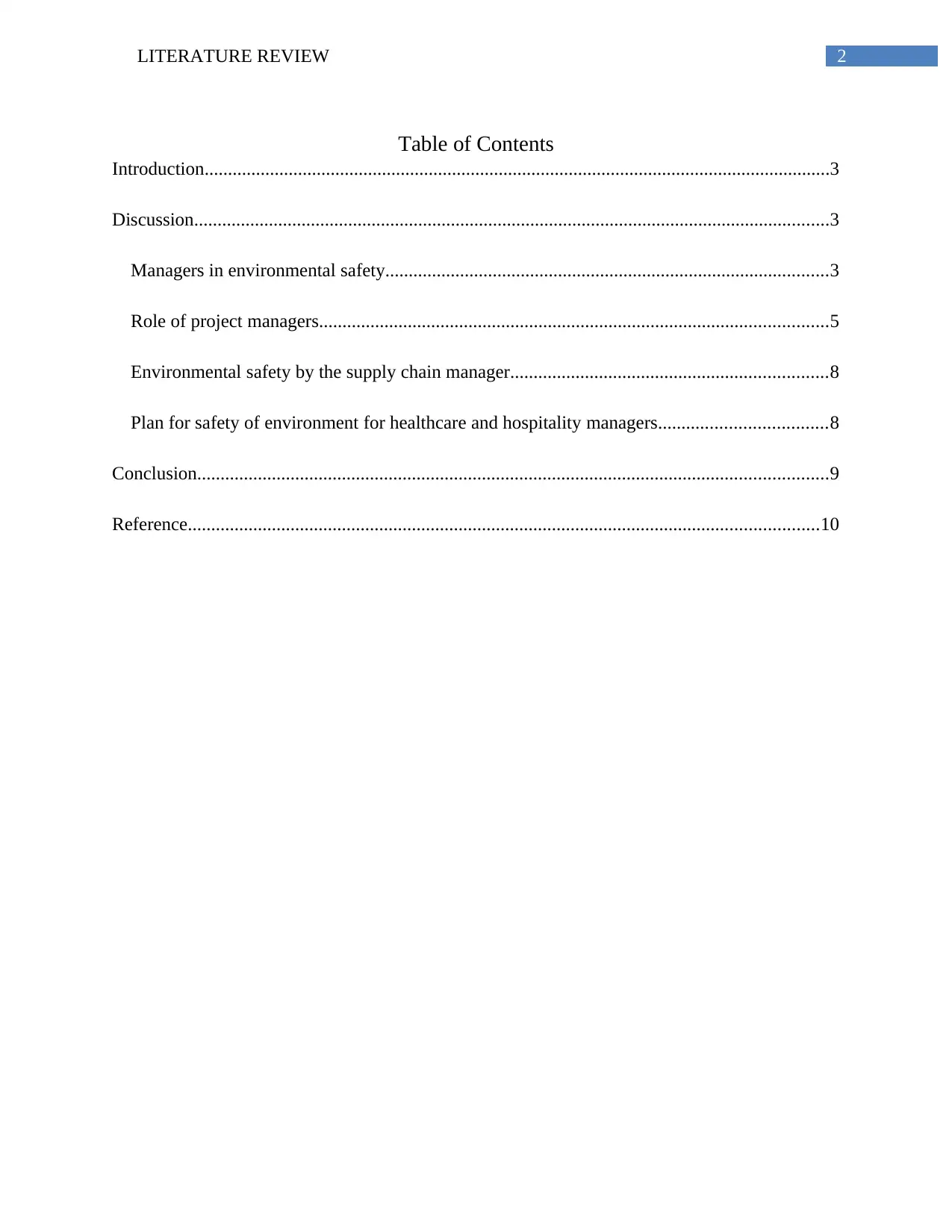
2LITERATURE REVIEW
Table of Contents
Introduction......................................................................................................................................3
Discussion........................................................................................................................................3
Managers in environmental safety...............................................................................................3
Role of project managers.............................................................................................................5
Environmental safety by the supply chain manager....................................................................8
Plan for safety of environment for healthcare and hospitality managers....................................8
Conclusion.......................................................................................................................................9
Reference.......................................................................................................................................10
Table of Contents
Introduction......................................................................................................................................3
Discussion........................................................................................................................................3
Managers in environmental safety...............................................................................................3
Role of project managers.............................................................................................................5
Environmental safety by the supply chain manager....................................................................8
Plan for safety of environment for healthcare and hospitality managers....................................8
Conclusion.......................................................................................................................................9
Reference.......................................................................................................................................10
⊘ This is a preview!⊘
Do you want full access?
Subscribe today to unlock all pages.

Trusted by 1+ million students worldwide
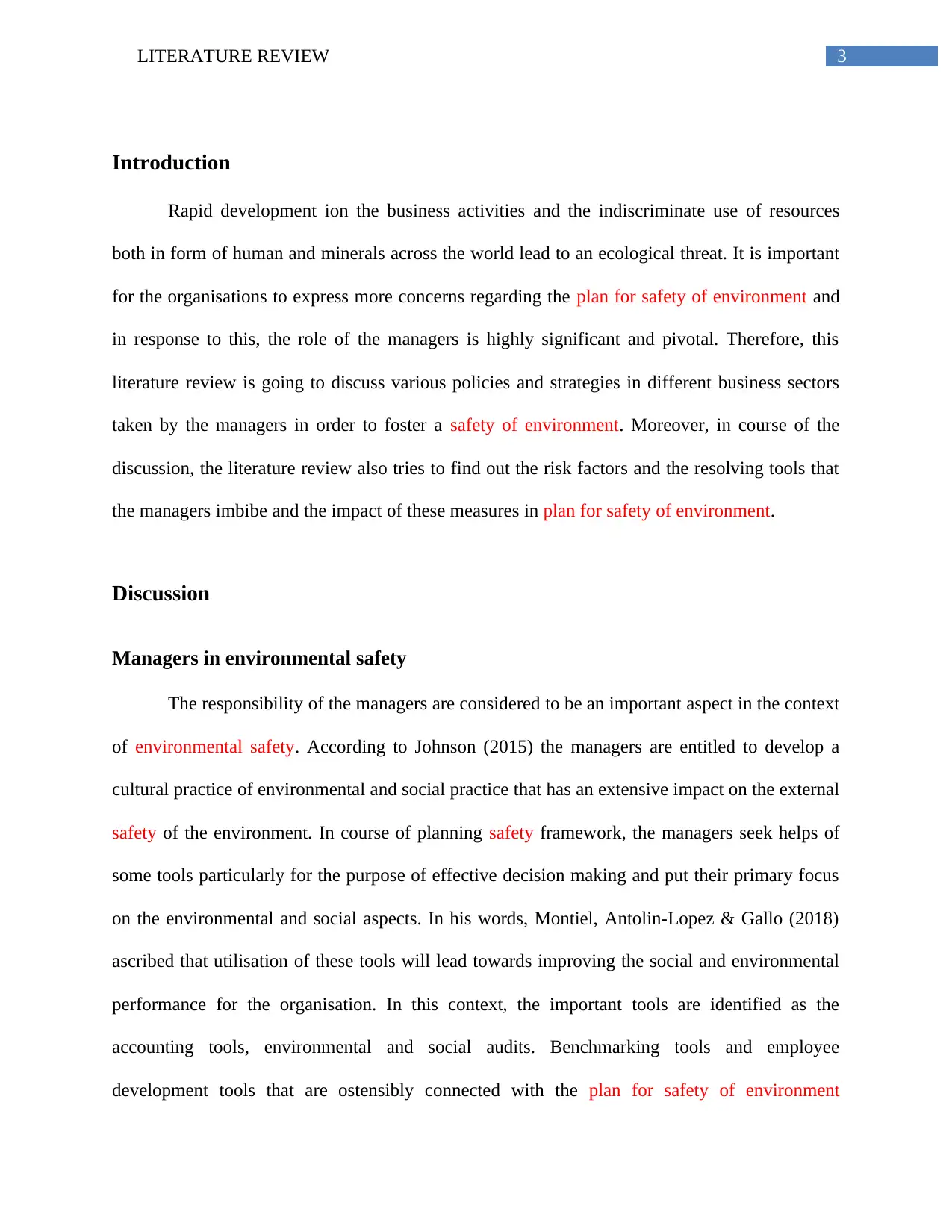
3LITERATURE REVIEW
Introduction
Rapid development ion the business activities and the indiscriminate use of resources
both in form of human and minerals across the world lead to an ecological threat. It is important
for the organisations to express more concerns regarding the plan for safety of environment and
in response to this, the role of the managers is highly significant and pivotal. Therefore, this
literature review is going to discuss various policies and strategies in different business sectors
taken by the managers in order to foster a safety of environment. Moreover, in course of the
discussion, the literature review also tries to find out the risk factors and the resolving tools that
the managers imbibe and the impact of these measures in plan for safety of environment.
Discussion
Managers in environmental safety
The responsibility of the managers are considered to be an important aspect in the context
of environmental safety. According to Johnson (2015) the managers are entitled to develop a
cultural practice of environmental and social practice that has an extensive impact on the external
safety of the environment. In course of planning safety framework, the managers seek helps of
some tools particularly for the purpose of effective decision making and put their primary focus
on the environmental and social aspects. In his words, Montiel, Antolin-Lopez & Gallo (2018)
ascribed that utilisation of these tools will lead towards improving the social and environmental
performance for the organisation. In this context, the important tools are identified as the
accounting tools, environmental and social audits. Benchmarking tools and employee
development tools that are ostensibly connected with the plan for safety of environment
Introduction
Rapid development ion the business activities and the indiscriminate use of resources
both in form of human and minerals across the world lead to an ecological threat. It is important
for the organisations to express more concerns regarding the plan for safety of environment and
in response to this, the role of the managers is highly significant and pivotal. Therefore, this
literature review is going to discuss various policies and strategies in different business sectors
taken by the managers in order to foster a safety of environment. Moreover, in course of the
discussion, the literature review also tries to find out the risk factors and the resolving tools that
the managers imbibe and the impact of these measures in plan for safety of environment.
Discussion
Managers in environmental safety
The responsibility of the managers are considered to be an important aspect in the context
of environmental safety. According to Johnson (2015) the managers are entitled to develop a
cultural practice of environmental and social practice that has an extensive impact on the external
safety of the environment. In course of planning safety framework, the managers seek helps of
some tools particularly for the purpose of effective decision making and put their primary focus
on the environmental and social aspects. In his words, Montiel, Antolin-Lopez & Gallo (2018)
ascribed that utilisation of these tools will lead towards improving the social and environmental
performance for the organisation. In this context, the important tools are identified as the
accounting tools, environmental and social audits. Benchmarking tools and employee
development tools that are ostensibly connected with the plan for safety of environment
Paraphrase This Document
Need a fresh take? Get an instant paraphrase of this document with our AI Paraphraser
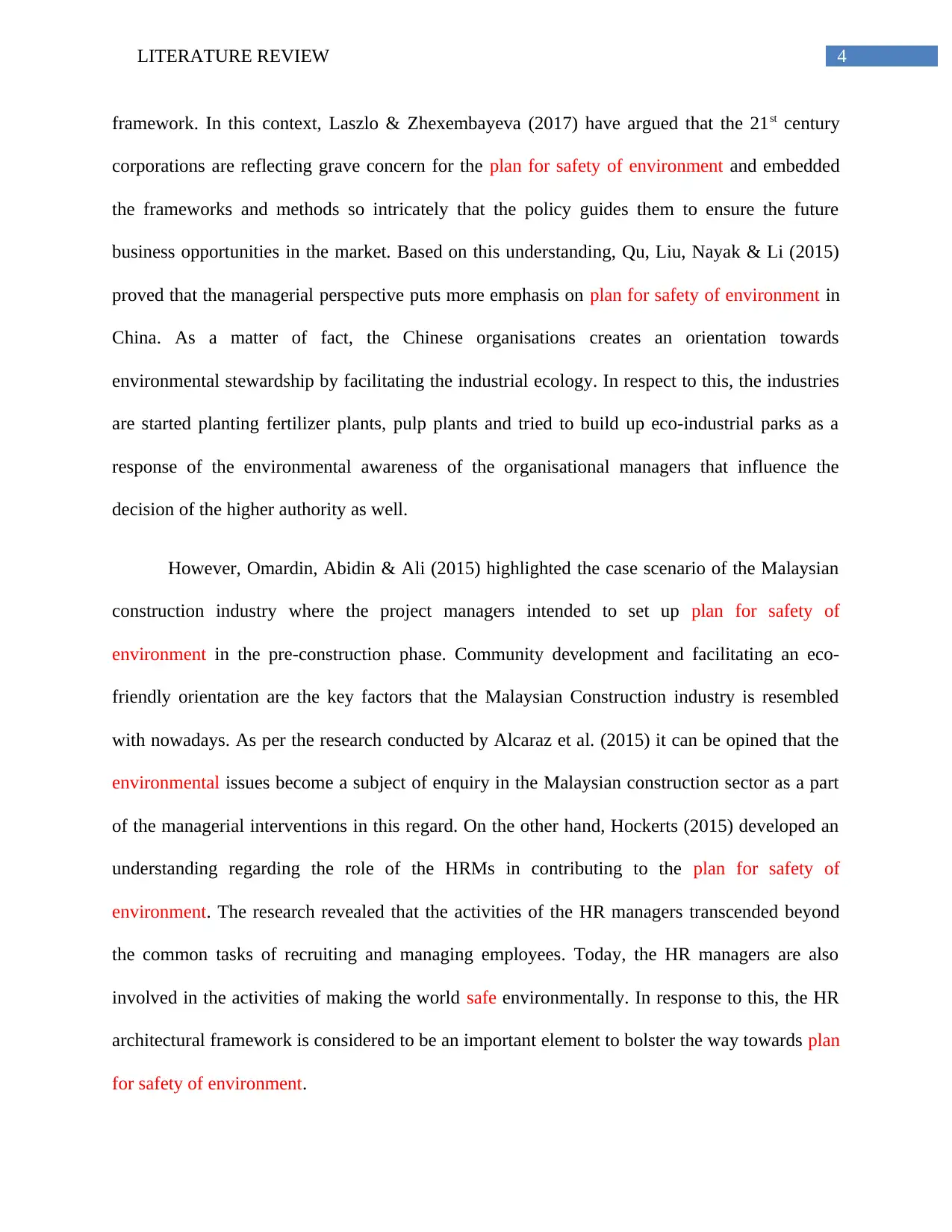
4LITERATURE REVIEW
framework. In this context, Laszlo & Zhexembayeva (2017) have argued that the 21st century
corporations are reflecting grave concern for the plan for safety of environment and embedded
the frameworks and methods so intricately that the policy guides them to ensure the future
business opportunities in the market. Based on this understanding, Qu, Liu, Nayak & Li (2015)
proved that the managerial perspective puts more emphasis on plan for safety of environment in
China. As a matter of fact, the Chinese organisations creates an orientation towards
environmental stewardship by facilitating the industrial ecology. In respect to this, the industries
are started planting fertilizer plants, pulp plants and tried to build up eco-industrial parks as a
response of the environmental awareness of the organisational managers that influence the
decision of the higher authority as well.
However, Omardin, Abidin & Ali (2015) highlighted the case scenario of the Malaysian
construction industry where the project managers intended to set up plan for safety of
environment in the pre-construction phase. Community development and facilitating an eco-
friendly orientation are the key factors that the Malaysian Construction industry is resembled
with nowadays. As per the research conducted by Alcaraz et al. (2015) it can be opined that the
environmental issues become a subject of enquiry in the Malaysian construction sector as a part
of the managerial interventions in this regard. On the other hand, Hockerts (2015) developed an
understanding regarding the role of the HRMs in contributing to the plan for safety of
environment. The research revealed that the activities of the HR managers transcended beyond
the common tasks of recruiting and managing employees. Today, the HR managers are also
involved in the activities of making the world safe environmentally. In response to this, the HR
architectural framework is considered to be an important element to bolster the way towards plan
for safety of environment.
framework. In this context, Laszlo & Zhexembayeva (2017) have argued that the 21st century
corporations are reflecting grave concern for the plan for safety of environment and embedded
the frameworks and methods so intricately that the policy guides them to ensure the future
business opportunities in the market. Based on this understanding, Qu, Liu, Nayak & Li (2015)
proved that the managerial perspective puts more emphasis on plan for safety of environment in
China. As a matter of fact, the Chinese organisations creates an orientation towards
environmental stewardship by facilitating the industrial ecology. In respect to this, the industries
are started planting fertilizer plants, pulp plants and tried to build up eco-industrial parks as a
response of the environmental awareness of the organisational managers that influence the
decision of the higher authority as well.
However, Omardin, Abidin & Ali (2015) highlighted the case scenario of the Malaysian
construction industry where the project managers intended to set up plan for safety of
environment in the pre-construction phase. Community development and facilitating an eco-
friendly orientation are the key factors that the Malaysian Construction industry is resembled
with nowadays. As per the research conducted by Alcaraz et al. (2015) it can be opined that the
environmental issues become a subject of enquiry in the Malaysian construction sector as a part
of the managerial interventions in this regard. On the other hand, Hockerts (2015) developed an
understanding regarding the role of the HRMs in contributing to the plan for safety of
environment. The research revealed that the activities of the HR managers transcended beyond
the common tasks of recruiting and managing employees. Today, the HR managers are also
involved in the activities of making the world safe environmentally. In response to this, the HR
architectural framework is considered to be an important element to bolster the way towards plan
for safety of environment.
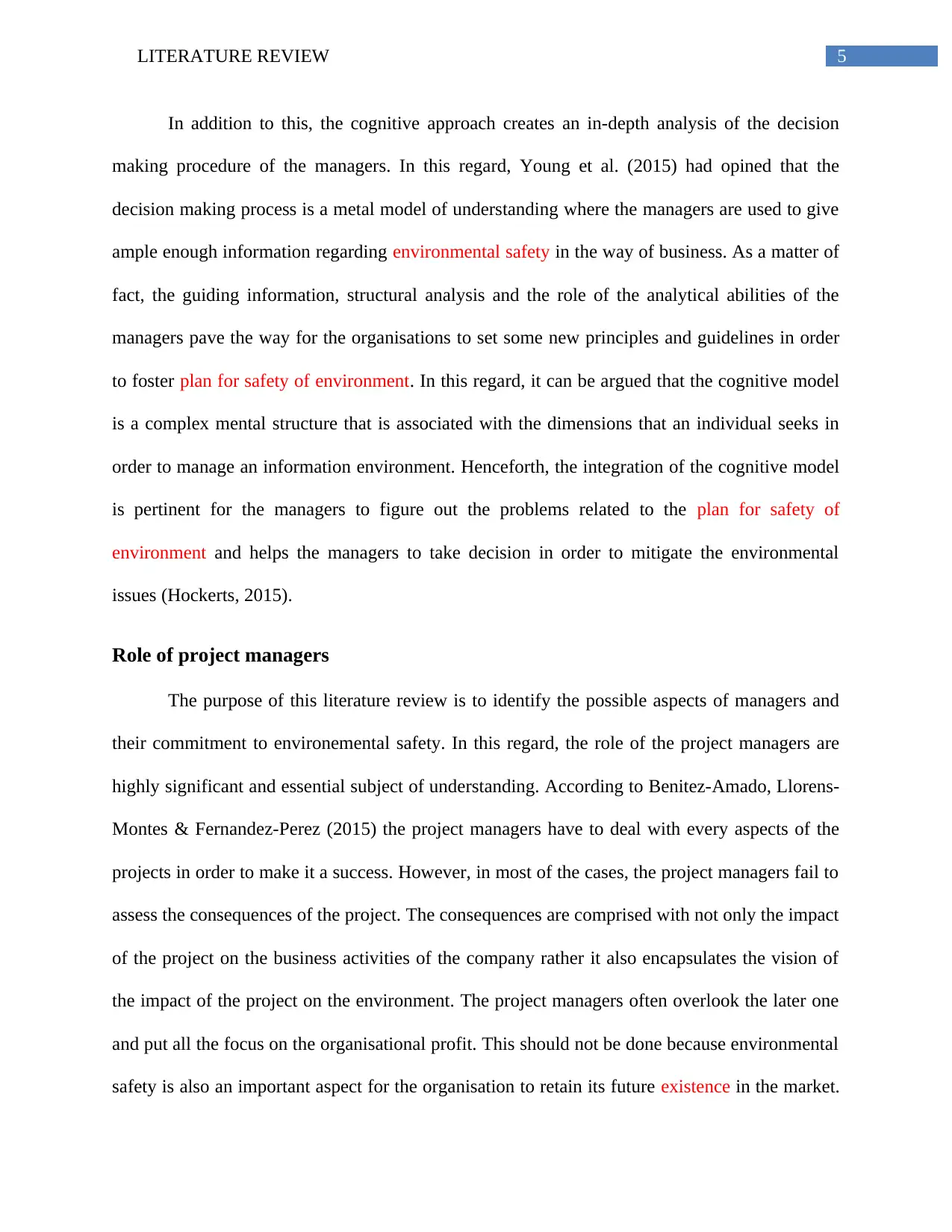
5LITERATURE REVIEW
In addition to this, the cognitive approach creates an in-depth analysis of the decision
making procedure of the managers. In this regard, Young et al. (2015) had opined that the
decision making process is a metal model of understanding where the managers are used to give
ample enough information regarding environmental safety in the way of business. As a matter of
fact, the guiding information, structural analysis and the role of the analytical abilities of the
managers pave the way for the organisations to set some new principles and guidelines in order
to foster plan for safety of environment. In this regard, it can be argued that the cognitive model
is a complex mental structure that is associated with the dimensions that an individual seeks in
order to manage an information environment. Henceforth, the integration of the cognitive model
is pertinent for the managers to figure out the problems related to the plan for safety of
environment and helps the managers to take decision in order to mitigate the environmental
issues (Hockerts, 2015).
Role of project managers
The purpose of this literature review is to identify the possible aspects of managers and
their commitment to environemental safety. In this regard, the role of the project managers are
highly significant and essential subject of understanding. According to Benitez-Amado, Llorens-
Montes & Fernandez-Perez (2015) the project managers have to deal with every aspects of the
projects in order to make it a success. However, in most of the cases, the project managers fail to
assess the consequences of the project. The consequences are comprised with not only the impact
of the project on the business activities of the company rather it also encapsulates the vision of
the impact of the project on the environment. The project managers often overlook the later one
and put all the focus on the organisational profit. This should not be done because environmental
safety is also an important aspect for the organisation to retain its future existence in the market.
In addition to this, the cognitive approach creates an in-depth analysis of the decision
making procedure of the managers. In this regard, Young et al. (2015) had opined that the
decision making process is a metal model of understanding where the managers are used to give
ample enough information regarding environmental safety in the way of business. As a matter of
fact, the guiding information, structural analysis and the role of the analytical abilities of the
managers pave the way for the organisations to set some new principles and guidelines in order
to foster plan for safety of environment. In this regard, it can be argued that the cognitive model
is a complex mental structure that is associated with the dimensions that an individual seeks in
order to manage an information environment. Henceforth, the integration of the cognitive model
is pertinent for the managers to figure out the problems related to the plan for safety of
environment and helps the managers to take decision in order to mitigate the environmental
issues (Hockerts, 2015).
Role of project managers
The purpose of this literature review is to identify the possible aspects of managers and
their commitment to environemental safety. In this regard, the role of the project managers are
highly significant and essential subject of understanding. According to Benitez-Amado, Llorens-
Montes & Fernandez-Perez (2015) the project managers have to deal with every aspects of the
projects in order to make it a success. However, in most of the cases, the project managers fail to
assess the consequences of the project. The consequences are comprised with not only the impact
of the project on the business activities of the company rather it also encapsulates the vision of
the impact of the project on the environment. The project managers often overlook the later one
and put all the focus on the organisational profit. This should not be done because environmental
safety is also an important aspect for the organisation to retain its future existence in the market.
⊘ This is a preview!⊘
Do you want full access?
Subscribe today to unlock all pages.

Trusted by 1+ million students worldwide
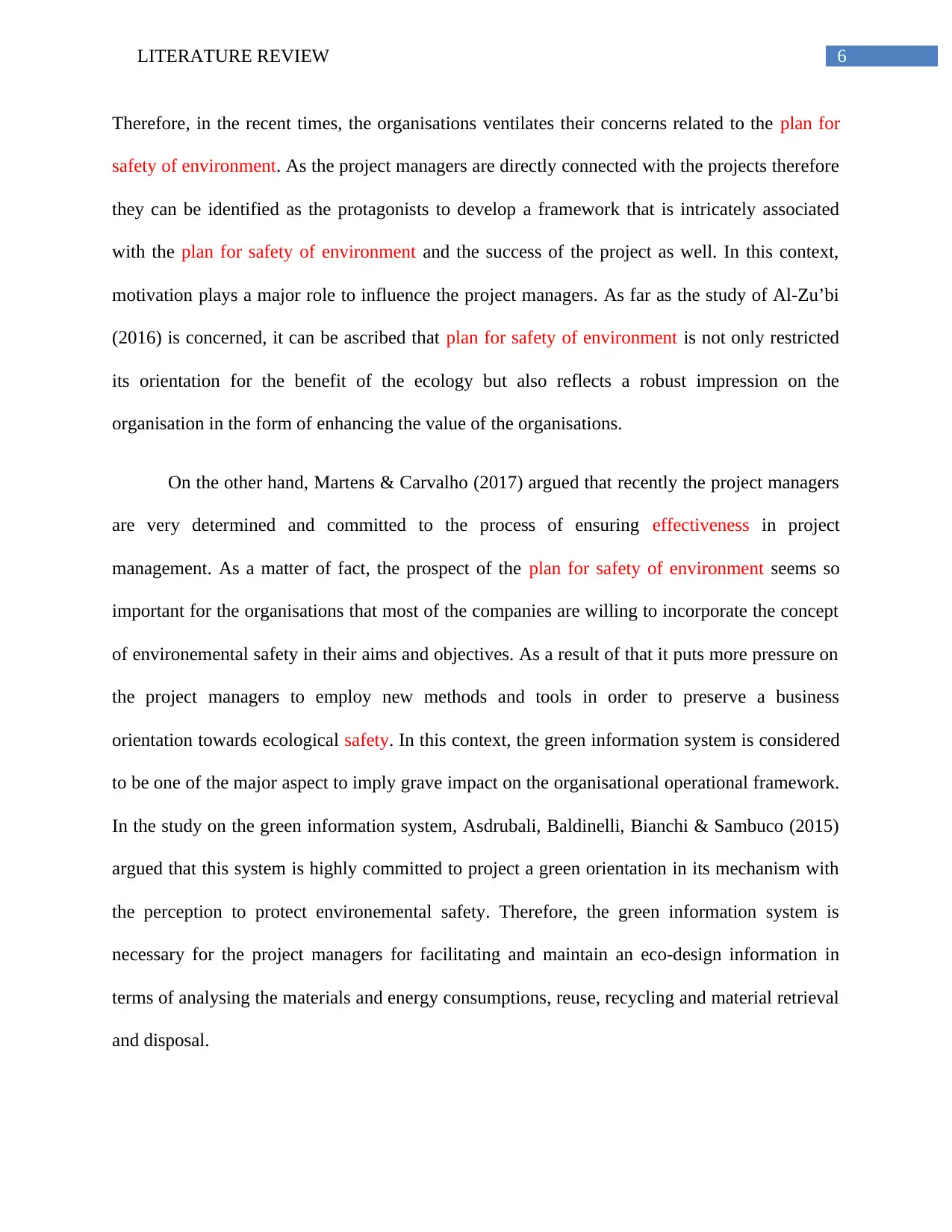
6LITERATURE REVIEW
Therefore, in the recent times, the organisations ventilates their concerns related to the plan for
safety of environment. As the project managers are directly connected with the projects therefore
they can be identified as the protagonists to develop a framework that is intricately associated
with the plan for safety of environment and the success of the project as well. In this context,
motivation plays a major role to influence the project managers. As far as the study of Al-Zu’bi
(2016) is concerned, it can be ascribed that plan for safety of environment is not only restricted
its orientation for the benefit of the ecology but also reflects a robust impression on the
organisation in the form of enhancing the value of the organisations.
On the other hand, Martens & Carvalho (2017) argued that recently the project managers
are very determined and committed to the process of ensuring effectiveness in project
management. As a matter of fact, the prospect of the plan for safety of environment seems so
important for the organisations that most of the companies are willing to incorporate the concept
of environemental safety in their aims and objectives. As a result of that it puts more pressure on
the project managers to employ new methods and tools in order to preserve a business
orientation towards ecological safety. In this context, the green information system is considered
to be one of the major aspect to imply grave impact on the organisational operational framework.
In the study on the green information system, Asdrubali, Baldinelli, Bianchi & Sambuco (2015)
argued that this system is highly committed to project a green orientation in its mechanism with
the perception to protect environemental safety. Therefore, the green information system is
necessary for the project managers for facilitating and maintain an eco-design information in
terms of analysing the materials and energy consumptions, reuse, recycling and material retrieval
and disposal.
Therefore, in the recent times, the organisations ventilates their concerns related to the plan for
safety of environment. As the project managers are directly connected with the projects therefore
they can be identified as the protagonists to develop a framework that is intricately associated
with the plan for safety of environment and the success of the project as well. In this context,
motivation plays a major role to influence the project managers. As far as the study of Al-Zu’bi
(2016) is concerned, it can be ascribed that plan for safety of environment is not only restricted
its orientation for the benefit of the ecology but also reflects a robust impression on the
organisation in the form of enhancing the value of the organisations.
On the other hand, Martens & Carvalho (2017) argued that recently the project managers
are very determined and committed to the process of ensuring effectiveness in project
management. As a matter of fact, the prospect of the plan for safety of environment seems so
important for the organisations that most of the companies are willing to incorporate the concept
of environemental safety in their aims and objectives. As a result of that it puts more pressure on
the project managers to employ new methods and tools in order to preserve a business
orientation towards ecological safety. In this context, the green information system is considered
to be one of the major aspect to imply grave impact on the organisational operational framework.
In the study on the green information system, Asdrubali, Baldinelli, Bianchi & Sambuco (2015)
argued that this system is highly committed to project a green orientation in its mechanism with
the perception to protect environemental safety. Therefore, the green information system is
necessary for the project managers for facilitating and maintain an eco-design information in
terms of analysing the materials and energy consumptions, reuse, recycling and material retrieval
and disposal.
Paraphrase This Document
Need a fresh take? Get an instant paraphrase of this document with our AI Paraphraser
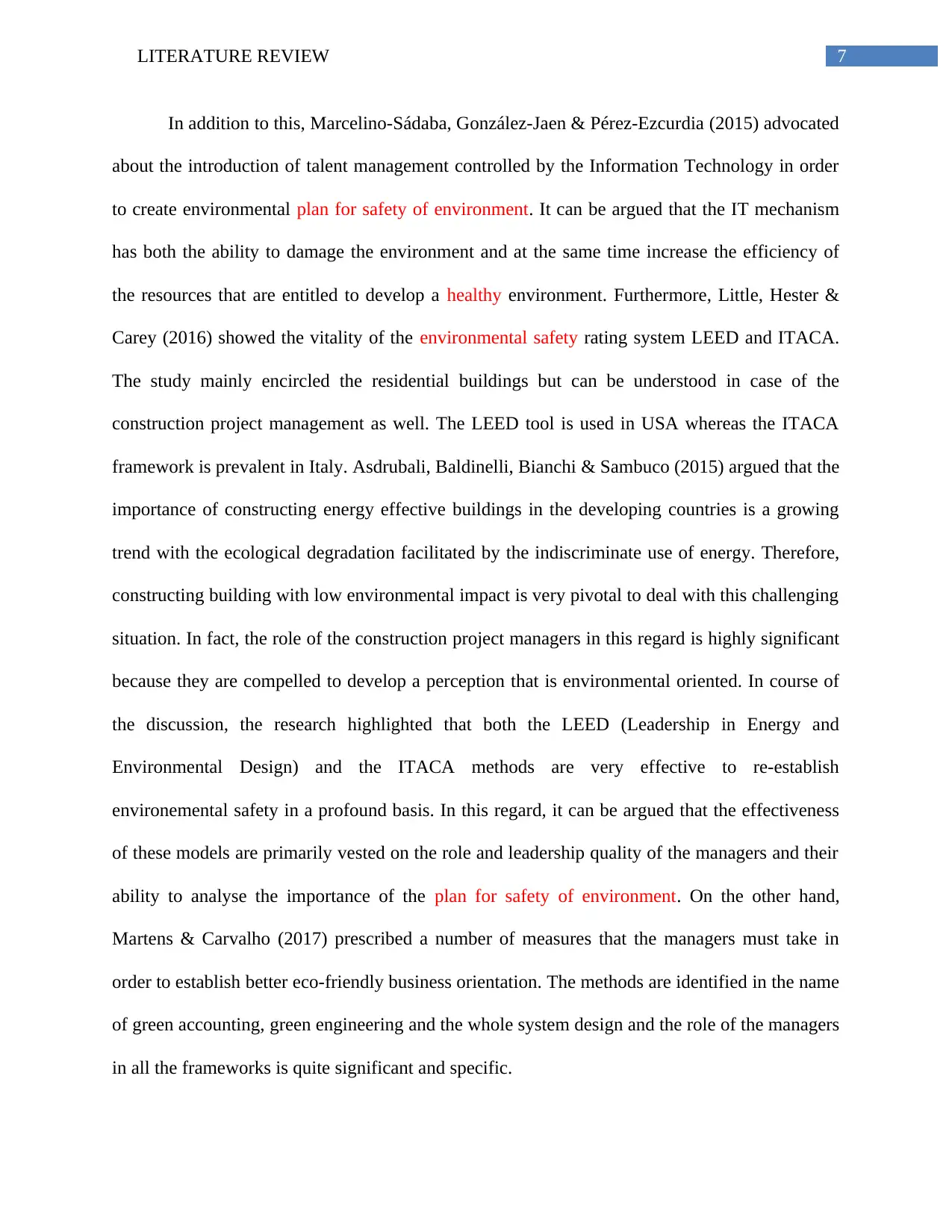
7LITERATURE REVIEW
In addition to this, Marcelino-Sádaba, González-Jaen & Pérez-Ezcurdia (2015) advocated
about the introduction of talent management controlled by the Information Technology in order
to create environmental plan for safety of environment. It can be argued that the IT mechanism
has both the ability to damage the environment and at the same time increase the efficiency of
the resources that are entitled to develop a healthy environment. Furthermore, Little, Hester &
Carey (2016) showed the vitality of the environmental safety rating system LEED and ITACA.
The study mainly encircled the residential buildings but can be understood in case of the
construction project management as well. The LEED tool is used in USA whereas the ITACA
framework is prevalent in Italy. Asdrubali, Baldinelli, Bianchi & Sambuco (2015) argued that the
importance of constructing energy effective buildings in the developing countries is a growing
trend with the ecological degradation facilitated by the indiscriminate use of energy. Therefore,
constructing building with low environmental impact is very pivotal to deal with this challenging
situation. In fact, the role of the construction project managers in this regard is highly significant
because they are compelled to develop a perception that is environmental oriented. In course of
the discussion, the research highlighted that both the LEED (Leadership in Energy and
Environmental Design) and the ITACA methods are very effective to re-establish
environemental safety in a profound basis. In this regard, it can be argued that the effectiveness
of these models are primarily vested on the role and leadership quality of the managers and their
ability to analyse the importance of the plan for safety of environment. On the other hand,
Martens & Carvalho (2017) prescribed a number of measures that the managers must take in
order to establish better eco-friendly business orientation. The methods are identified in the name
of green accounting, green engineering and the whole system design and the role of the managers
in all the frameworks is quite significant and specific.
In addition to this, Marcelino-Sádaba, González-Jaen & Pérez-Ezcurdia (2015) advocated
about the introduction of talent management controlled by the Information Technology in order
to create environmental plan for safety of environment. It can be argued that the IT mechanism
has both the ability to damage the environment and at the same time increase the efficiency of
the resources that are entitled to develop a healthy environment. Furthermore, Little, Hester &
Carey (2016) showed the vitality of the environmental safety rating system LEED and ITACA.
The study mainly encircled the residential buildings but can be understood in case of the
construction project management as well. The LEED tool is used in USA whereas the ITACA
framework is prevalent in Italy. Asdrubali, Baldinelli, Bianchi & Sambuco (2015) argued that the
importance of constructing energy effective buildings in the developing countries is a growing
trend with the ecological degradation facilitated by the indiscriminate use of energy. Therefore,
constructing building with low environmental impact is very pivotal to deal with this challenging
situation. In fact, the role of the construction project managers in this regard is highly significant
because they are compelled to develop a perception that is environmental oriented. In course of
the discussion, the research highlighted that both the LEED (Leadership in Energy and
Environmental Design) and the ITACA methods are very effective to re-establish
environemental safety in a profound basis. In this regard, it can be argued that the effectiveness
of these models are primarily vested on the role and leadership quality of the managers and their
ability to analyse the importance of the plan for safety of environment. On the other hand,
Martens & Carvalho (2017) prescribed a number of measures that the managers must take in
order to establish better eco-friendly business orientation. The methods are identified in the name
of green accounting, green engineering and the whole system design and the role of the managers
in all the frameworks is quite significant and specific.
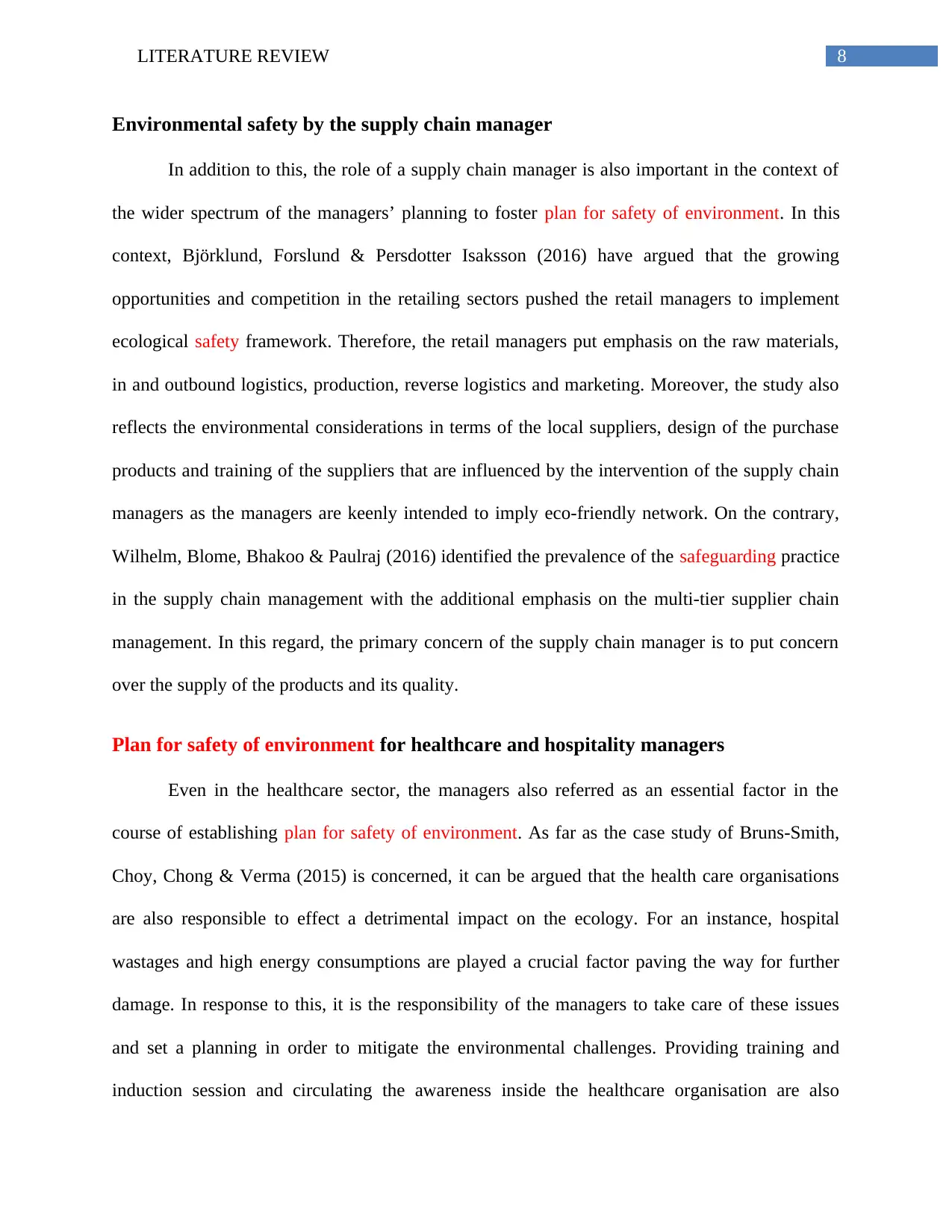
8LITERATURE REVIEW
Environmental safety by the supply chain manager
In addition to this, the role of a supply chain manager is also important in the context of
the wider spectrum of the managers’ planning to foster plan for safety of environment. In this
context, Björklund, Forslund & Persdotter Isaksson (2016) have argued that the growing
opportunities and competition in the retailing sectors pushed the retail managers to implement
ecological safety framework. Therefore, the retail managers put emphasis on the raw materials,
in and outbound logistics, production, reverse logistics and marketing. Moreover, the study also
reflects the environmental considerations in terms of the local suppliers, design of the purchase
products and training of the suppliers that are influenced by the intervention of the supply chain
managers as the managers are keenly intended to imply eco-friendly network. On the contrary,
Wilhelm, Blome, Bhakoo & Paulraj (2016) identified the prevalence of the safeguarding practice
in the supply chain management with the additional emphasis on the multi-tier supplier chain
management. In this regard, the primary concern of the supply chain manager is to put concern
over the supply of the products and its quality.
Plan for safety of environment for healthcare and hospitality managers
Even in the healthcare sector, the managers also referred as an essential factor in the
course of establishing plan for safety of environment. As far as the case study of Bruns-Smith,
Choy, Chong & Verma (2015) is concerned, it can be argued that the health care organisations
are also responsible to effect a detrimental impact on the ecology. For an instance, hospital
wastages and high energy consumptions are played a crucial factor paving the way for further
damage. In response to this, it is the responsibility of the managers to take care of these issues
and set a planning in order to mitigate the environmental challenges. Providing training and
induction session and circulating the awareness inside the healthcare organisation are also
Environmental safety by the supply chain manager
In addition to this, the role of a supply chain manager is also important in the context of
the wider spectrum of the managers’ planning to foster plan for safety of environment. In this
context, Björklund, Forslund & Persdotter Isaksson (2016) have argued that the growing
opportunities and competition in the retailing sectors pushed the retail managers to implement
ecological safety framework. Therefore, the retail managers put emphasis on the raw materials,
in and outbound logistics, production, reverse logistics and marketing. Moreover, the study also
reflects the environmental considerations in terms of the local suppliers, design of the purchase
products and training of the suppliers that are influenced by the intervention of the supply chain
managers as the managers are keenly intended to imply eco-friendly network. On the contrary,
Wilhelm, Blome, Bhakoo & Paulraj (2016) identified the prevalence of the safeguarding practice
in the supply chain management with the additional emphasis on the multi-tier supplier chain
management. In this regard, the primary concern of the supply chain manager is to put concern
over the supply of the products and its quality.
Plan for safety of environment for healthcare and hospitality managers
Even in the healthcare sector, the managers also referred as an essential factor in the
course of establishing plan for safety of environment. As far as the case study of Bruns-Smith,
Choy, Chong & Verma (2015) is concerned, it can be argued that the health care organisations
are also responsible to effect a detrimental impact on the ecology. For an instance, hospital
wastages and high energy consumptions are played a crucial factor paving the way for further
damage. In response to this, it is the responsibility of the managers to take care of these issues
and set a planning in order to mitigate the environmental challenges. Providing training and
induction session and circulating the awareness inside the healthcare organisation are also
⊘ This is a preview!⊘
Do you want full access?
Subscribe today to unlock all pages.

Trusted by 1+ million students worldwide
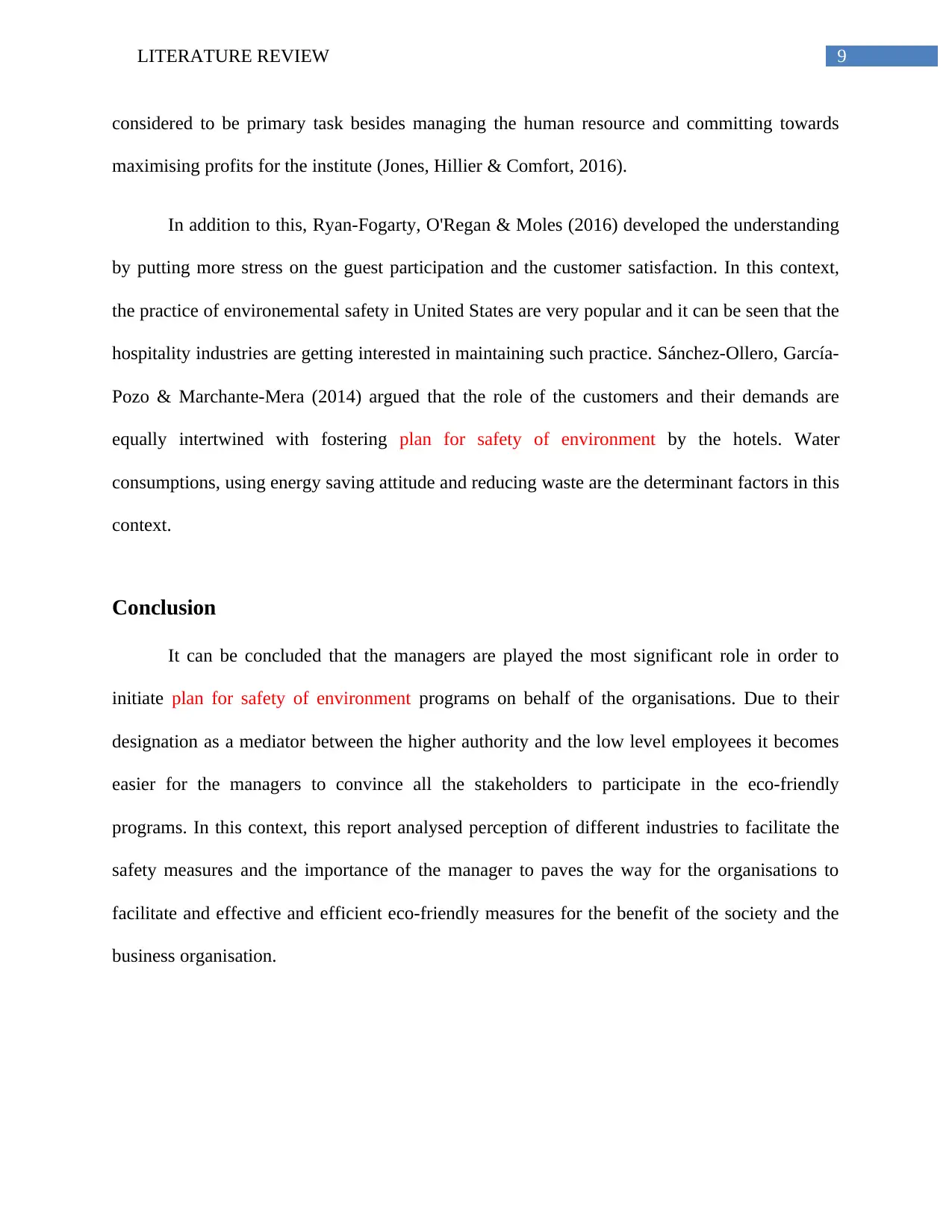
9LITERATURE REVIEW
considered to be primary task besides managing the human resource and committing towards
maximising profits for the institute (Jones, Hillier & Comfort, 2016).
In addition to this, Ryan-Fogarty, O'Regan & Moles (2016) developed the understanding
by putting more stress on the guest participation and the customer satisfaction. In this context,
the practice of environemental safety in United States are very popular and it can be seen that the
hospitality industries are getting interested in maintaining such practice. Sánchez-Ollero, García-
Pozo & Marchante-Mera (2014) argued that the role of the customers and their demands are
equally intertwined with fostering plan for safety of environment by the hotels. Water
consumptions, using energy saving attitude and reducing waste are the determinant factors in this
context.
Conclusion
It can be concluded that the managers are played the most significant role in order to
initiate plan for safety of environment programs on behalf of the organisations. Due to their
designation as a mediator between the higher authority and the low level employees it becomes
easier for the managers to convince all the stakeholders to participate in the eco-friendly
programs. In this context, this report analysed perception of different industries to facilitate the
safety measures and the importance of the manager to paves the way for the organisations to
facilitate and effective and efficient eco-friendly measures for the benefit of the society and the
business organisation.
considered to be primary task besides managing the human resource and committing towards
maximising profits for the institute (Jones, Hillier & Comfort, 2016).
In addition to this, Ryan-Fogarty, O'Regan & Moles (2016) developed the understanding
by putting more stress on the guest participation and the customer satisfaction. In this context,
the practice of environemental safety in United States are very popular and it can be seen that the
hospitality industries are getting interested in maintaining such practice. Sánchez-Ollero, García-
Pozo & Marchante-Mera (2014) argued that the role of the customers and their demands are
equally intertwined with fostering plan for safety of environment by the hotels. Water
consumptions, using energy saving attitude and reducing waste are the determinant factors in this
context.
Conclusion
It can be concluded that the managers are played the most significant role in order to
initiate plan for safety of environment programs on behalf of the organisations. Due to their
designation as a mediator between the higher authority and the low level employees it becomes
easier for the managers to convince all the stakeholders to participate in the eco-friendly
programs. In this context, this report analysed perception of different industries to facilitate the
safety measures and the importance of the manager to paves the way for the organisations to
facilitate and effective and efficient eco-friendly measures for the benefit of the society and the
business organisation.
Paraphrase This Document
Need a fresh take? Get an instant paraphrase of this document with our AI Paraphraser
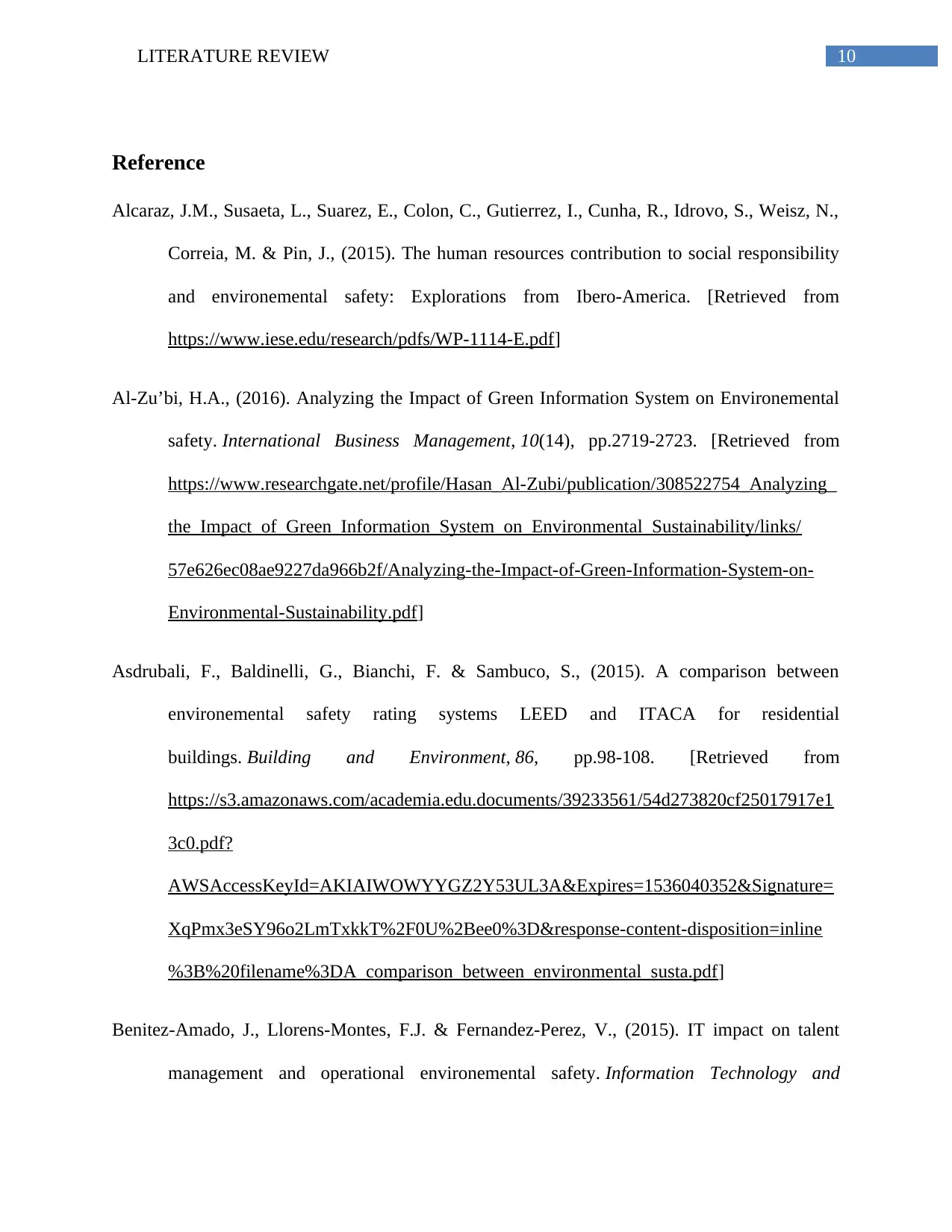
10LITERATURE REVIEW
Reference
Alcaraz, J.M., Susaeta, L., Suarez, E., Colon, C., Gutierrez, I., Cunha, R., Idrovo, S., Weisz, N.,
Correia, M. & Pin, J., (2015). The human resources contribution to social responsibility
and environemental safety: Explorations from Ibero-America. [Retrieved from
https://www.iese.edu/research/pdfs/WP-1114-E.pdf]
Al-Zu’bi, H.A., (2016). Analyzing the Impact of Green Information System on Environemental
safety. International Business Management, 10(14), pp.2719-2723. [Retrieved from
https://www.researchgate.net/profile/Hasan_Al-Zubi/publication/308522754_Analyzing_
the_Impact_of_Green_Information_System_on_Environmental_Sustainability/links/
57e626ec08ae9227da966b2f/Analyzing-the-Impact-of-Green-Information-System-on-
Environmental-Sustainability.pdf]
Asdrubali, F., Baldinelli, G., Bianchi, F. & Sambuco, S., (2015). A comparison between
environemental safety rating systems LEED and ITACA for residential
buildings. Building and Environment, 86, pp.98-108. [Retrieved from
https://s3.amazonaws.com/academia.edu.documents/39233561/54d273820cf25017917e1
3c0.pdf?
AWSAccessKeyId=AKIAIWOWYYGZ2Y53UL3A&Expires=1536040352&Signature=
XqPmx3eSY96o2LmTxkkT%2F0U%2Bee0%3D&response-content-disposition=inline
%3B%20filename%3DA_comparison_between_environmental_susta.pdf]
Benitez-Amado, J., Llorens-Montes, F.J. & Fernandez-Perez, V., (2015). IT impact on talent
management and operational environemental safety. Information Technology and
Reference
Alcaraz, J.M., Susaeta, L., Suarez, E., Colon, C., Gutierrez, I., Cunha, R., Idrovo, S., Weisz, N.,
Correia, M. & Pin, J., (2015). The human resources contribution to social responsibility
and environemental safety: Explorations from Ibero-America. [Retrieved from
https://www.iese.edu/research/pdfs/WP-1114-E.pdf]
Al-Zu’bi, H.A., (2016). Analyzing the Impact of Green Information System on Environemental
safety. International Business Management, 10(14), pp.2719-2723. [Retrieved from
https://www.researchgate.net/profile/Hasan_Al-Zubi/publication/308522754_Analyzing_
the_Impact_of_Green_Information_System_on_Environmental_Sustainability/links/
57e626ec08ae9227da966b2f/Analyzing-the-Impact-of-Green-Information-System-on-
Environmental-Sustainability.pdf]
Asdrubali, F., Baldinelli, G., Bianchi, F. & Sambuco, S., (2015). A comparison between
environemental safety rating systems LEED and ITACA for residential
buildings. Building and Environment, 86, pp.98-108. [Retrieved from
https://s3.amazonaws.com/academia.edu.documents/39233561/54d273820cf25017917e1
3c0.pdf?
AWSAccessKeyId=AKIAIWOWYYGZ2Y53UL3A&Expires=1536040352&Signature=
XqPmx3eSY96o2LmTxkkT%2F0U%2Bee0%3D&response-content-disposition=inline
%3B%20filename%3DA_comparison_between_environmental_susta.pdf]
Benitez-Amado, J., Llorens-Montes, F.J. & Fernandez-Perez, V., (2015). IT impact on talent
management and operational environemental safety. Information Technology and
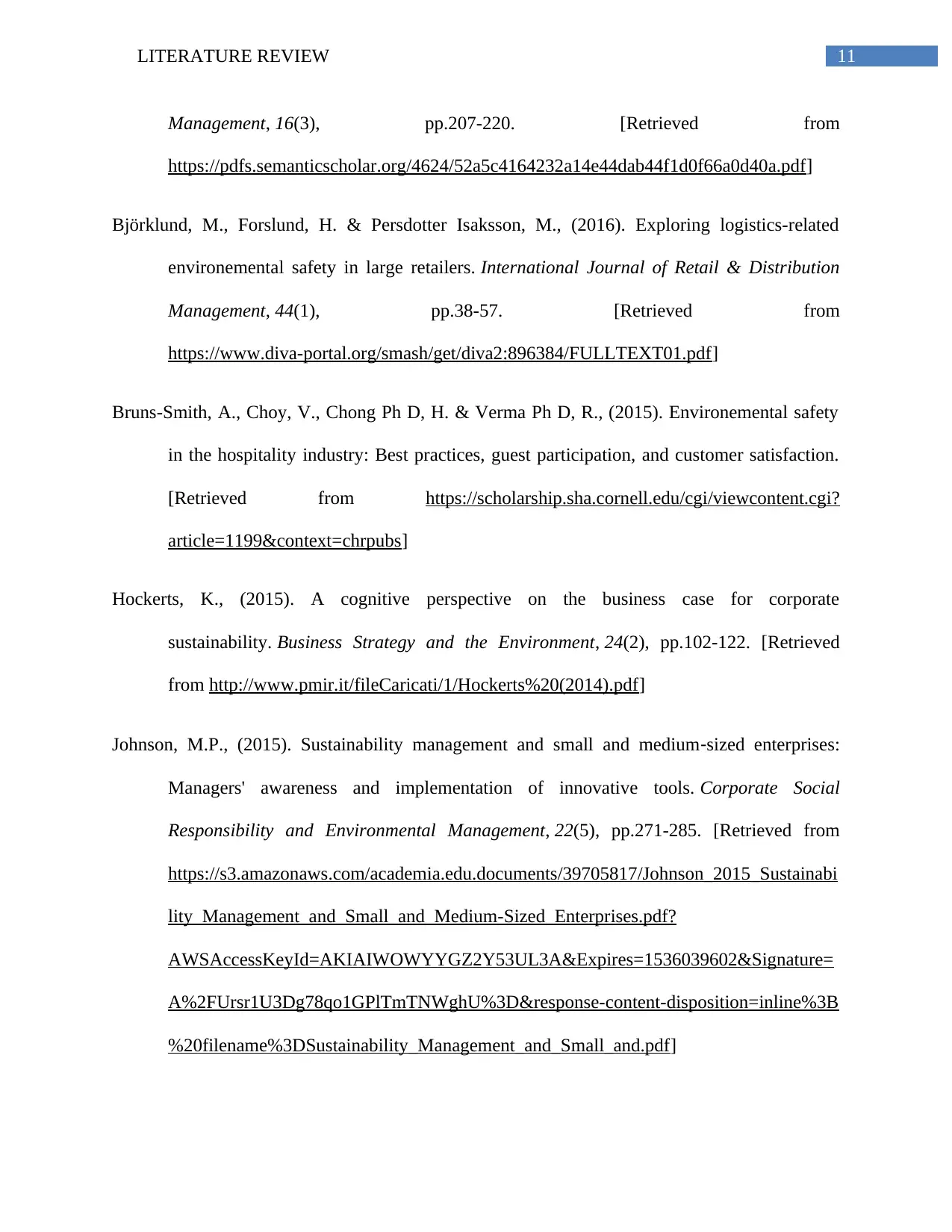
11LITERATURE REVIEW
Management, 16(3), pp.207-220. [Retrieved from
https://pdfs.semanticscholar.org/4624/52a5c4164232a14e44dab44f1d0f66a0d40a.pdf]
Björklund, M., Forslund, H. & Persdotter Isaksson, M., (2016). Exploring logistics-related
environemental safety in large retailers. International Journal of Retail & Distribution
Management, 44(1), pp.38-57. [Retrieved from
https://www.diva-portal.org/smash/get/diva2:896384/FULLTEXT01.pdf]
Bruns-Smith, A., Choy, V., Chong Ph D, H. & Verma Ph D, R., (2015). Environemental safety
in the hospitality industry: Best practices, guest participation, and customer satisfaction.
[Retrieved from https://scholarship.sha.cornell.edu/cgi/viewcontent.cgi?
article=1199&context=chrpubs]
Hockerts, K., (2015). A cognitive perspective on the business case for corporate
sustainability. Business Strategy and the Environment, 24(2), pp.102-122. [Retrieved
from http://www.pmir.it/fileCaricati/1/Hockerts%20(2014).pdf]
Johnson, M.P., (2015). Sustainability management and small and medium‐sized enterprises:
Managers' awareness and implementation of innovative tools. Corporate Social
Responsibility and Environmental Management, 22(5), pp.271-285. [Retrieved from
https://s3.amazonaws.com/academia.edu.documents/39705817/Johnson_2015_Sustainabi
lity_Management_and_Small_and_Medium-Sized_Enterprises.pdf?
AWSAccessKeyId=AKIAIWOWYYGZ2Y53UL3A&Expires=1536039602&Signature=
A%2FUrsr1U3Dg78qo1GPlTmTNWghU%3D&response-content-disposition=inline%3B
%20filename%3DSustainability_Management_and_Small_and.pdf]
Management, 16(3), pp.207-220. [Retrieved from
https://pdfs.semanticscholar.org/4624/52a5c4164232a14e44dab44f1d0f66a0d40a.pdf]
Björklund, M., Forslund, H. & Persdotter Isaksson, M., (2016). Exploring logistics-related
environemental safety in large retailers. International Journal of Retail & Distribution
Management, 44(1), pp.38-57. [Retrieved from
https://www.diva-portal.org/smash/get/diva2:896384/FULLTEXT01.pdf]
Bruns-Smith, A., Choy, V., Chong Ph D, H. & Verma Ph D, R., (2015). Environemental safety
in the hospitality industry: Best practices, guest participation, and customer satisfaction.
[Retrieved from https://scholarship.sha.cornell.edu/cgi/viewcontent.cgi?
article=1199&context=chrpubs]
Hockerts, K., (2015). A cognitive perspective on the business case for corporate
sustainability. Business Strategy and the Environment, 24(2), pp.102-122. [Retrieved
from http://www.pmir.it/fileCaricati/1/Hockerts%20(2014).pdf]
Johnson, M.P., (2015). Sustainability management and small and medium‐sized enterprises:
Managers' awareness and implementation of innovative tools. Corporate Social
Responsibility and Environmental Management, 22(5), pp.271-285. [Retrieved from
https://s3.amazonaws.com/academia.edu.documents/39705817/Johnson_2015_Sustainabi
lity_Management_and_Small_and_Medium-Sized_Enterprises.pdf?
AWSAccessKeyId=AKIAIWOWYYGZ2Y53UL3A&Expires=1536039602&Signature=
A%2FUrsr1U3Dg78qo1GPlTmTNWghU%3D&response-content-disposition=inline%3B
%20filename%3DSustainability_Management_and_Small_and.pdf]
⊘ This is a preview!⊘
Do you want full access?
Subscribe today to unlock all pages.

Trusted by 1+ million students worldwide
1 out of 15
Related Documents
Your All-in-One AI-Powered Toolkit for Academic Success.
+13062052269
info@desklib.com
Available 24*7 on WhatsApp / Email
![[object Object]](/_next/static/media/star-bottom.7253800d.svg)
Unlock your academic potential
Copyright © 2020–2025 A2Z Services. All Rights Reserved. Developed and managed by ZUCOL.





